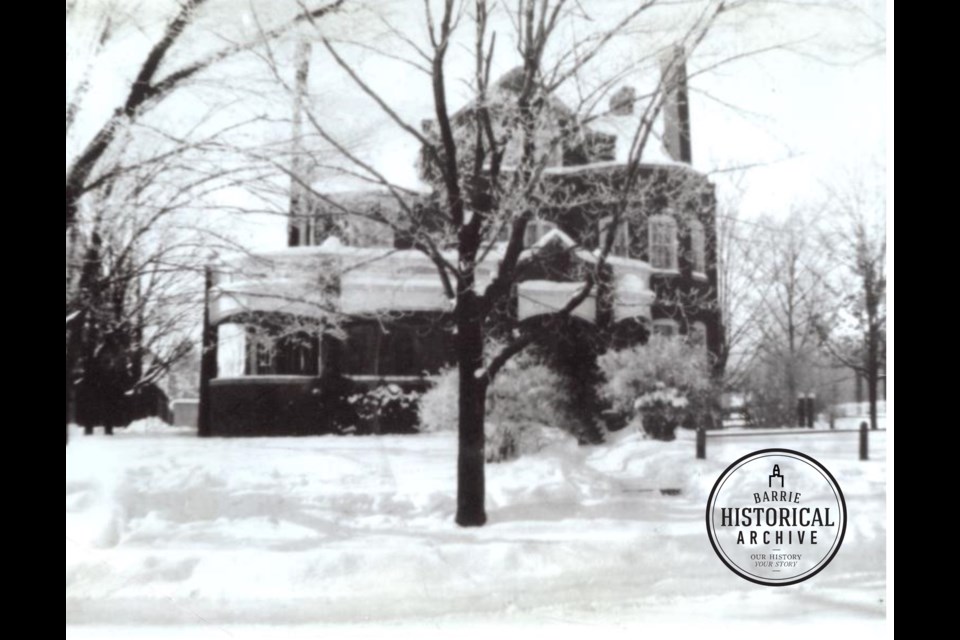This ongoing series from Barrie Historical Archive curator Deb Exel shows old photos from the collection and one from the present day, as well as the story behind them.
It’s fair to credit the larger-than-life Dyment family for their part in helping to create an area of stylish homes on High Street in the historic Queen’s Park neighbourhood.
It all began with lumber king Nathaniel Dyment, born in Devonshire, England, who came to Canada in 1832 as a baby. The Dyments settled in the Hamilton area where Nathaniel, at 17, went into the lumber and logging business. In 1871, Dyment obtained a license to remove timber from the Thessalon Indian Reservation. He built the area’s first significant steam-powered sawmill at the mouth of the Thessalon River, essentially launching the lumber industry in that region. Dyment is generally regarded as the founder of the town of Thessalon.
Dyment’s success and wealth grew as he built mills along the route of the Great Western Railway. He extended his operations into Simcoe County when timber supplies in Southern Ontario dwindled. In 1870, Nathaniel moved to Barrie to be closer to his business interests. And there would be many. Dyment was partner in numerous lumber companies around the province, a founding member of the Barrie Gas Company, President of Dyment Securities Loan and Savings, Director of the Collingwood Shipbuilding Company, had interest in the Barrie Carriage Company and he served on Town Council from 1872-6. In spite of all this obvious success and wealth, Dyment was said to be an honest, square-dealing, quiet and unassuming man. Nathaniel Dyment’s passion for horseracing and his famous Brookdale Stables earned him a place in the Canadian Horseracing Hall of Fame.
Rowanhurst, the home of Nathaniel Dyment and his wife Annie McRae, stood at the northeast corner of Elizabeth Street (now Dunlop Street West) and High Street. Rowanhurst was a lovely, sprawling home, set back from the street, with an impressive fountain in front, a coach house in the back and a solarium that would be added to the home. Their close neighbour behind them, the Fletcher home, would later become the Barrie General Hospital.
In 1883, Nathaniel built a sumptuous home, Maplehurst, for his son Simon. Simon Dyment and his wife Annie White, had 6 children: 5 boys and 1 girl. And it was Simon who, in 1907, built the impressive home at 74 High Street as a wedding gift for his son Harold and his bride Agnes Lockerbie Campbell.
Harold Marmaduke Dyment, born in 1880, spent his life in Barrie, attending local schools before heading to Ridley College in St. Catherine’s. During the war he served overseas with the 157th Battalion Simcoe Foresters, and back home he was a gentleman and managed the Oakley Park Farm … many folks may think of it as Newton’s Farm or the historic Rose Cottage .
Harold’s bride was Agnes Lockerbie Campbell of Collingwood, daughter of Peter McLean Campbell, also known as Captain Black Pete Campbell. Campbell captained many Great Lakes steamers including the steamship Manitoulin. In 1882, when fire broke out aboard the Manitoulin, laden with passengers and 500 pounds of explosives destined for the Canadian Pacific Railway construction crews to the north, it was Campbell’s quick response to the terrifying situation that minimized the loss of life. Agnes Lockerbie Campbell’s grandfather was blacksmith and Collingwood mayor from 1889-90, Andrew Lockerbie.
The newlyweds’ stylish house was an imposing, Tudor-influenced structure at the corner of High and Park Streets. Harold and Aggie’s home had a unique 5-sided bow window, expansive veranda, an oriel window on the north side and parapeted gables. Harold, First Vice President of the Canadian Kennel Club in 1911, had a kennel built at the rear of the property for his prize winning cocker spaniels. Harold also had a whippet named Pete who liked to chase the horses and buggies going by 74 High Street. The kennel was later converted to a small house. The ‘new’ Dyment home at the end of High Street complimented the block of striking mansions. Harold and Aggie would raise 3 sons, Ted, Bill and Herb, in their handsome home.
Back in the day, it was not uncommon for households to have live in in help. The large home of a wealthy family such as the Dyment’s was no exception. Alice Squires was part of the domestic staff that kept the grand home functioning. Alice’s grandson tells her story:
“Alice and Amy Squires came to Canada from England in 1912 as many children in the care of Barnardo’s Home had done since the 1880’s. Alice was 11 years old, Amy just 9 at the time (an anxious ocean crossing as this was just two months after the sinking of the Titanic). Both girls, though never together, were contracted out as domestics to live and work at the farms and households of a number of rural Ontario families. In 1922, Amy was “situated” at the Harold Dyment residence at 74 High Street. Alice, who had aged out of the guardianship of Barnardo’s about this time, was hired as a “live-in” by the Dyment family late in August of 1922, allowing the girls to live together for the first time since their arrival.
While at this address, Alice met a young deliveryman named Archie Longhurst. Archie lived nearby on Toronto Street. On January 16th, 1923, Alice and Archie married. The couple would have six children in all. Archie began a career with the GTR/CNR that would see the family live principally in Belleville, Cobourg and Toronto. The Longhurst family came to Canada from England in 1832 as part of the Petworth Emigration Project with many a descendant living in Simcoe County over the years and to the present day.
Amy would take the domestic experience with the Dyment's to get work at “blue book” clubs and similar places in Toronto. The sisters lived near each other in the mid-1930’s when Archie worked in Toronto at the CNR railyard on Spadina Avenue. A family story passed down was that, when Amy would visit, she would sometimes bring shrimp. Amy would marry and settle in The Beaches ending her working career at the Royal York Hotel. Alice and Archie would spend many years living in Belleville. Alice lived about 20 years longer than her sister or husband, passing away at the age of 92.”
Unlike Alice, Harold Dyment would not know the privilege of old age. Tragedy struck only 22 years into Harold and Aggie’s marriage, when he passed away after a lengthy illness in 1929.
After a suitable amount of time, millionaire William Wright of Statenborough, proposed to the widow Dyment. Wright had bought the Dyment’s Brookdale Farm in the early 1920’s. Aggie declined Wright’s proposal, but she would marry again. This time to John Laing, a local bachelor, banker and secretary/treasurer at Trinity Anglican Church. John’s parents were from Dundee, Scotland: his dad had been the head gardener of the gardens below Edinburgh Castle. Aggie and John would happily reside at 74 High Street, the house often filled with family and friends – it was a house made for entertaining.
Most people will never see the inside of a Barrie grand homes, but thanks to Aggie’s grandchildren, Part Two of ’74 High Street’ will be a rare ‘tour’ inside of one of the marvelous Dyment homes.




